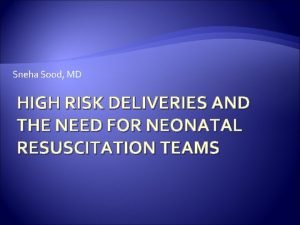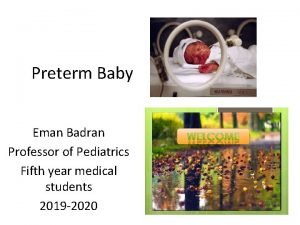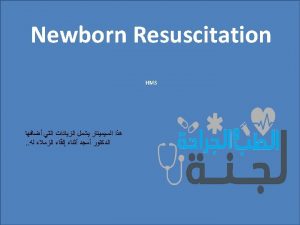Knowledge Skills and Use of Neonatal Resuscitation in

![• • • [1] Lawn, JE, Lee ACC, Kinney M, et al. Two • • • [1] Lawn, JE, Lee ACC, Kinney M, et al. Two](https://slidetodoc.com/presentation_image_h2/ecc03d3f3fd97eeea4649f9704689c2d/image-2.jpg)
- Slides: 2

Knowledge, Skills, and Use of Neonatal Resuscitation in Lesotho, Before and After Participation in a Helping Babies Breathe Train-the-Trainer Program Jennifer Werdenberg MD*~, Rebecca Hoban MD MPH+, Acacia Cognata MD MSPH*, Asad Moten BS#, Norma Perez DO**, Lineo Thahane*~ MD, Edith Mohapi, MD*~, Elizabeth Montgomery MD MPH*~^ *Baylor College of Medicine Dept. of Pediatrics, ~Baylor International Pediatric AIDS Initiative (BIPAI); +Tufts U. Dept. of Pediatrics, Section of Neonatology; # Harvard-MIT School of Bioengineering; **UT-H Dept. of Pediatrics, Section of Infectious Diseases; ^Baylor College of Medicine, Dept. of Pediatrics, Section of Retrovirology & Global Health Course: Helping Babies Breathe (HBB) is a new evidence-based neonatal resuscitation education curriculum specifically designed for low resource countries Goal: Describe efficacy of teaching HBB in the real-world setting of Maseru, Lesotho Background: • First hour & day are critical times in newborn survival, 60 -70% of neonatal deaths occur within 24 hrs 1, 2 • Common causes of neonatal death 3: • Birth asphyxia • Infection • Prematurity • ~27 -30% of neonatal deaths are from birth asphyxia or failure to initiate and sustain breaths at birth 4 • Lesotho: • Population ~2 million 5 • Infant mortality 91/1000 live births (2010) 6 Learner characteristics (n = 17) • 15/17 (88%) of learners are nurse midwives • 13/17 (76%) work in community-level clinic or health center • 4/17 (24%) work at a district, regional, or national hospital • 17/17 (100%) report previous use of BMV, although not all report previous training • 5/17 (29%) had been trained on a simulator before this course Quantitative Results: • Comparison of post-test knowledge MCQ taken immediately after the course and 3 -8 mo after the Methods: • Evaluation of improved knowledge via: • Pre- and post-testing of knowledge via 16 -question multiple-choice questionnaire (MCQ) • Pre- and post-test bag-mask ventilation (BMV) skills assessed using 7 -item validated checklist • Post-training objective structured clinical exams (OSCE) utilizing case-based neonatal scenarios • OSCE #1: scenario required learner to perform stimulation & suctioning on mannequin • OSCE #2: scenario required full resuscitation of mannequin with BMV & heart rate checks • Post-course qualitative survey • Evaluation of knowledge retention and dissemination of course by trainers via: • 3 -8 and 9 -12 month follow-up post-test (remaining data will be collected 9 -12 months after course) • 9 -12 month survey (remaining data will be collected 9 -12 months after course) course revealed no significant change in score, p >0. 01. Qualitative results: • Learners report confidence that they could save lives at birth and teach these skills to others • Learners report plans to train others within 6 months Conclusions: • Newborn resuscitation knowledge significantly improved and was retained 3 months after course • Bag-mask ventilation skills significantly improved after HBB course • Post-training OSCE scores indicate learner competency to perform basic neonatal resuscitation [1] Lawn, JE, Lee ACC, Kinney M, et al. Two million intrapartum-related stillbirths and neonatal deaths: where, why and what can be done? Int J Gynaecol Obstet. 2009; 07(suppl 1)S 5 -S 18, S 19 [2] Kruger C, Niemi M, Espeland H et al. The effects of standardised protocols of obstetric and neonatal care on perinatal and early neonatal mortality at a rural hospital in Tanzania. Int Health 2012; 4(1): 55 -62 [3] Black RE, Cousens S, Johnson HL, et al; Child Health Epidemiology Reference Group of WHO and UNICEF. Global, regional and national causes of child mortality in 2008: a systematic analysis. Lancet. 2010; 375(9730)1969 -1987 [4] Mwaniki MK, Atieno M, Lawn JE, Newton CR. Long term neurodevelopmental outcomes after intrauterine and neonatal insults: a systematic review. Lancet. 2012; 379 (9814)445 -452 [5] Department of economic and social affairs population division (2009) world population prospects table A 1 2008 revision. UN Retrieved 3/12/2009 [6] Lesotho MOH annual joint review report 2011
![1 Lawn JE Lee ACC Kinney M et al Two • • • [1] Lawn, JE, Lee ACC, Kinney M, et al. Two](https://slidetodoc.com/presentation_image_h2/ecc03d3f3fd97eeea4649f9704689c2d/image-2.jpg)
• • • [1] Lawn, JE, Lee ACC, Kinney M, et al. Two million intrapartum-related stillbirths and neonatal deaths: where, why and what can be done? Int J Gynaecol Obstet. 2009; 07(suppl 1)S 5 -S 18, S 19 [2] Kruger C, Niemi M, Espeland H et all. The effects of standardised protocols of obstetric and neonatal care on perinatal and early neonatal mortality at a rural hospital in Tanzania. Int Health 2012; 4(1): 55 -62 [3] Black RE, Cousens S, Johnson HL, et al; Child Health Epidemiology Reference Group of WHO and UNICEF. Global, regional and national causes of child mortality in 2008: a systematic analysis. Lancet. 2010; 375(9730)1969 -1987 [4] Mwaniki MK, Atieno M, Lawn JE, Newton CR. Long term neurodevelopmental outcomes after intrauterine and neonatal insults: a systematic review. Lancet. 2012; 379 (9814)445 -452 [5] Department of economic and social affairs population division (2009) world population prospects table A 1 2008 revision. UN Retrieved 3/12/2009 [6]Lesotho MOH annual joint review report 2011



